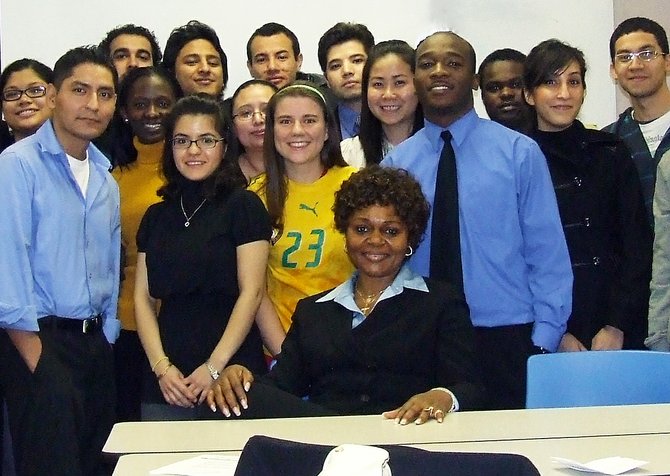Theresia Wansi, Ph.D., who teaches finance at Marymount University in Arlington, believes that those who develop sound financial habits when they are young will become adults who know how to budget, save and use credit judiciously. Photo courtesy of Marymount University
“Money comes from my daddy,” said Ian, a 7-year-old boy from Arlington, who is missing his front teeth.
“My parents got it from an ATM,” said 6-year-old Claire when asked about the origins of the $10 bill that she was using to buy a scoop of chocolate ice cream.
Financial experts say that as soon as children are aware of the purchasing power of money, parents should start teaching them how to use it wisely. Children who develop sound financial habits when they are young will become adults who know how to budget, save and use credit judiciously.
“What matters in life is not how much money you earn, but how you manage your finances. We hear stories all the time about people who make millions and end up broke.”
—Theresia Wansi, Ph.D., of Marymount University in Arlington
“No matter how young a child is, they can always learn good money practices,” said Theresia Wansi, an associate professor of finance at Marymount University in Arlington, “What matters in life is not how much money you earn, but how you manage your finances. We hear stories all the time about people who make millions and end up broke.”
Potomac, Md., resident Glen Buco, president of West Financial Services, says many financial advisers in his McLean office are also parents who are passing along penny-wise know-how to their children. “When their children receive money, the parents help them develop a budget using a “three bucket system,” said Buco. “One bucket is for saving, one is for spending and one for charity.”
Experts like Buco say wise shopping is a key component of money smarts: “When children want items like clothing or electronics, help them develop a budget with the money they’ve saved and then shop around,” he said. “One of the mothers in my office helped her 9-year-old daughter shop for shoes online by comparing prices, looking for discounts and free shipping.”
Ilham Nasser, an associate professor of early childhood education at George Mason University in Fairfax, says impulse control is often a stumbling block to financial stability. “Parents can teach self-regulation by using techniques like telling their children to count to 10 or take a deep breath or by playing simple games like ‘Simon Says’ to teach delayed gratification.”
Wansi says children should also be taught to keep track of the money that passes through their hands. “Everyone should have a spending diary,” she said. “Use a spreadsheet where the child lists what they spend. They might see that they are spending much more than they thought they were.”
Setting financial goals and working toward them is another strategy for managing urges to spend money frivolously. “Everyone can set short-term, intermediate and long-term financial goals,” said Wansi. “The goals you set have to be realistic and specific in measurable terms. For example, ‘I am going to get a part-time job to save for a $2,000 car in six months.’”
WHEN IT COMES TO LEARNING to save, experts say to start early. “Even an elementary school student who has $5 can be taught to save $2 in a piggy bank,” said Wansi. “When they are old enough to open a savings account, they can save money there.”
Parents can help their children understand expenses and how simple actions can save money by allowing them to see bills, due dates and the amount of money owed.
“If your children leave lights on all over the house and you yell at them, they’re not going to get it. You have to share your bills with your children,” said Wansi, who lives in Herndon. “When my kids were away at college, my bill was around $100 … and when they came back [for a school break] it was $500. I took the bills for them to see and they were amazed that a bill could be that expensive. Then everybody starting turning off lights without being asked.”
Nassar suggests parents use a show and tell approach: “Part of raising a child is being a role model and showing an ability to manage expenses,” she said. “When you go to the grocery store, take your children and say, ‘We have $100 today and we need to get these things. Let’s see which are the most important things.’ Help them think about priorities.”
Understanding credit is critical part of financial management, says Wansi: “In the U.S., it is hard to live without good credit. Teach children the advantages and pitfalls of credit. Beginning at middle school, it is important for children to understand the importance of good credit. I’ve talked to high school students who didn’t know that when you use credit cards you have to pay the money back.”
Buco says that debit cards might be a good alternative. “I’ve seen parents use these when their kids go off to college,” he said. “They would put money in the account and the kids can use the debit card. Several parents in my office who have 12- and 13-year-olds have set up debit cards with zero balances. When the kids find something they want to buy, [they can] move money out of savings into checking.”
